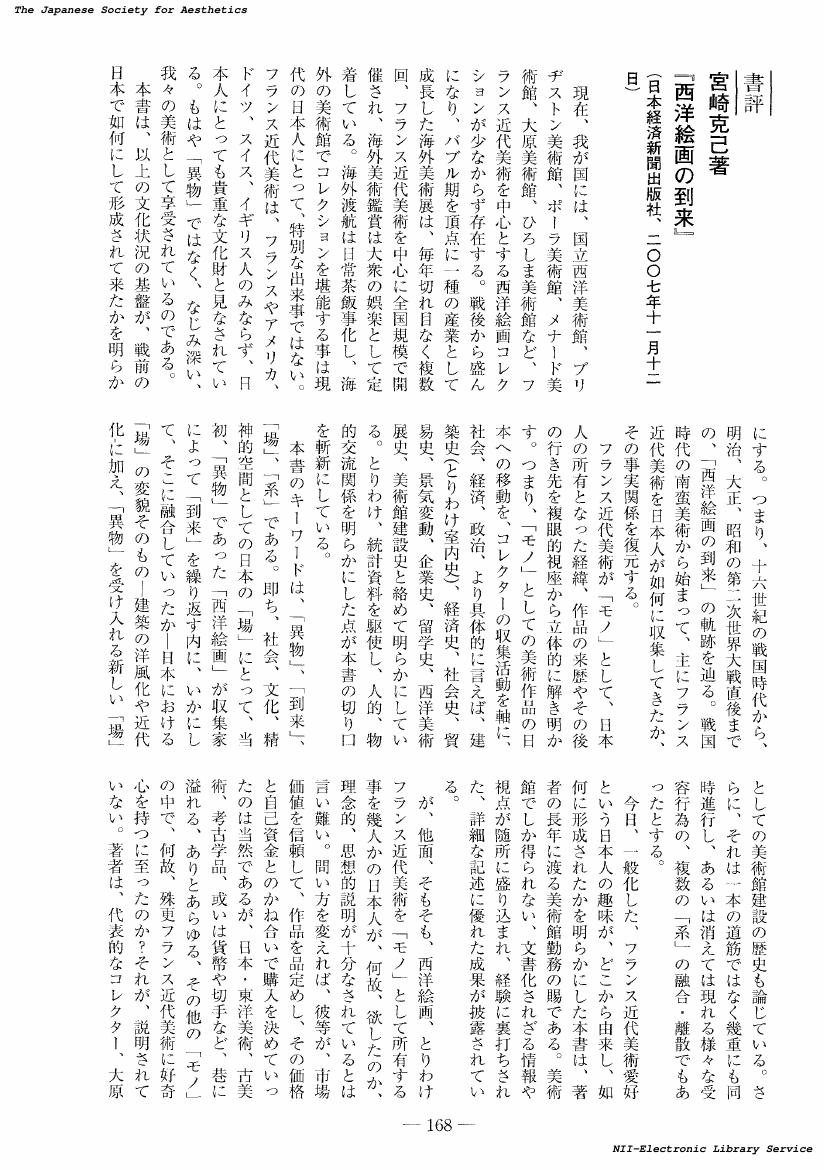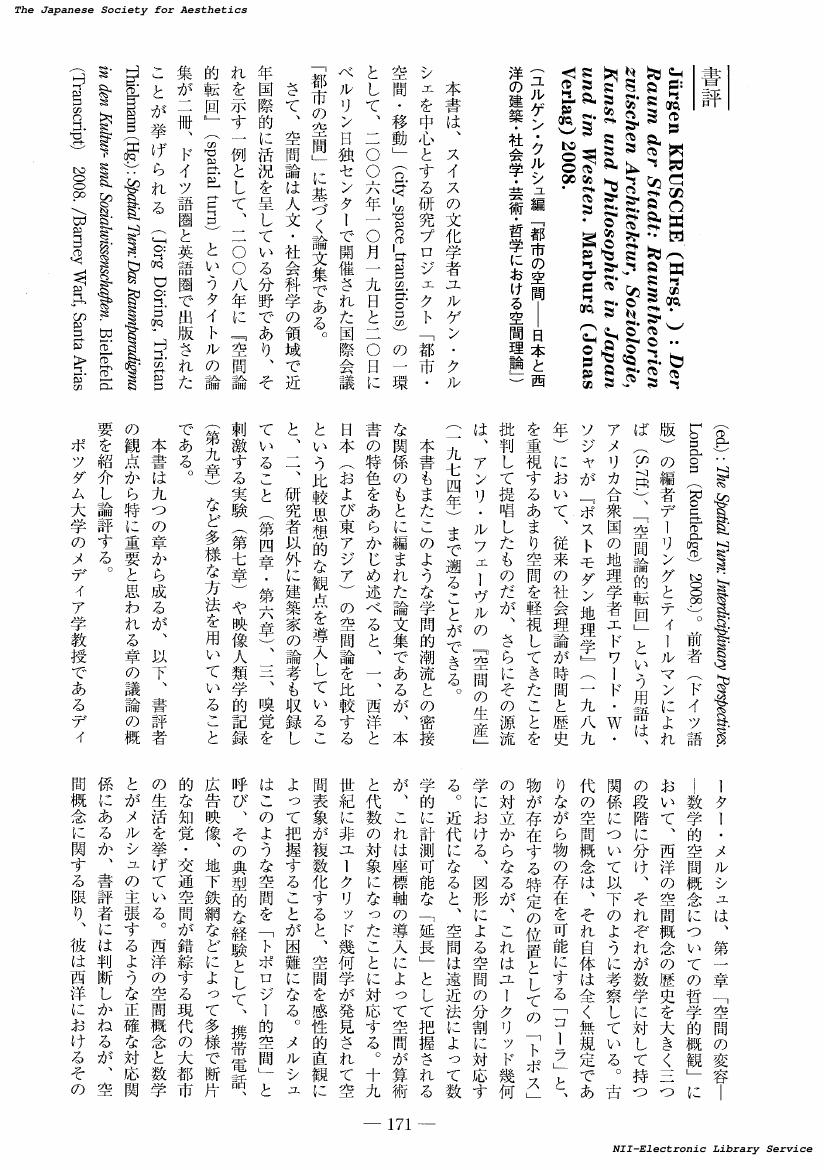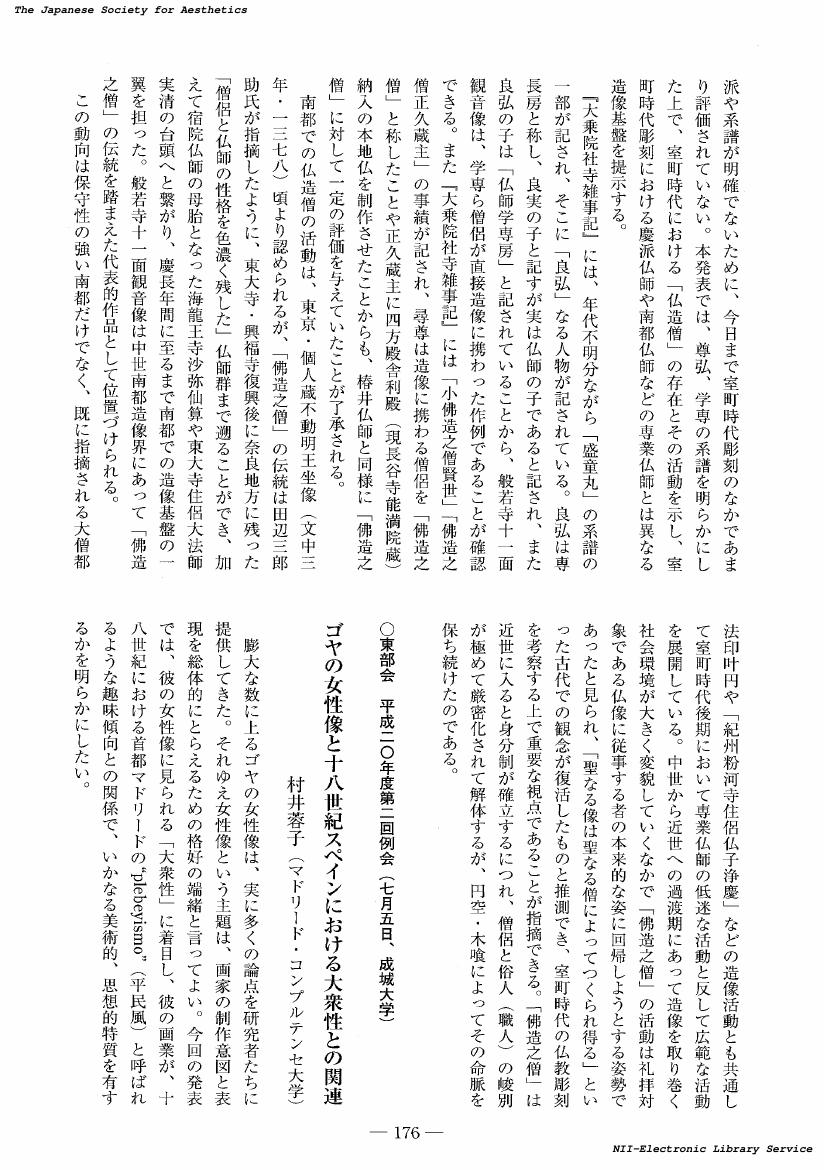- 著者
- 西田 紘子
- 出版者
- 美学会
- 雑誌
- 美学 (ISSN:05200962)
- 巻号頁・発行日
- vol.60, no.2, pp.30-43, 2009-12-31 (Released:2017-05-22)
This paper aims to re-examine Heinrich Schenker's (1868-1935) thoughts of music under the frame of musical hermeneutics, by comparing the hermeneutics of Schenker and Hermann Kretzschmar (1848-1924) as representatives of music analysis and musical hermeneutics through Dilthey's hermeneutics. While Kretzschmar proposed inner understanding by listening into "affects" as spiritual content from tones (1902; 1905), the object of Schenker's "true hermeneutics" (1913) was "tonal life," in which movements of tones and human life were identical. Although both correlated tones with "spiritual life," the difference exists in what they regarded as internal: for Schenker, the criterion was to be inside music, but Kretzschmar contrasted internal mentality with external tones. The discrepancy about inner/outer difference corresponds to the discrepancy between Dilthey's general and musical hermeneutics. Dilthey's distinction in 1900 coincided with Kretzschmar's in that the "inner" and "spiritual" expressed in external signs should be understood. However, in Dilthey's "The Musical Understanding" (c.1905), experience was internalized in music and "the life itself" was to be expressed. Interestingly, such a view resonates with Schenker's intramusical hermeneutics.
- 著者
- 坂手 佳絵
- 出版者
- 美学会
- 雑誌
- 美学 (ISSN:05200962)
- 巻号頁・発行日
- vol.60, no.1, pp.140-153, 2009-06-30 (Released:2017-05-22)
La tragedie lyrique (ou la tragedie en musique) est, pent-on dire, un genre symbolique au temps de l'Ancien Regime: elle prit son essor en commencant par Cadmus et Hermione de Lully et Quinault representee en 1673 et elle seteignit a la fin du XVIIIe siecle. Le destin de la tragedie lyrique alla de pair avec celui de la monarchie absolue. De nombreuses recherches sur ce genre lyrique de sa naissance aux annees 1760 ont ete effectuees jusqu'a present. Il est toutefois difficile d'affirmer que nous avons suffisamment aborde les oeuvres des annees 1770 et 1780. Dans cet article, nous essayons de mettre en evidence une image de la tragedie lyrique sous le regne de Louis XVI en examinant Thesee de Gossec. Au travers de l'etude de Thesee de Gossec, nous voyons que la tragedie lyrique resta toujours un genre important de l'aristocratie, spectateurs principals, pour ne pas perdre sa raison d'etre a la fin de l'Ancien Regime. Dans ces circonstances, Gossec dut tenter de jouter sa musique dans le moule deja demode de la tragedie lyrique. Ce qui permet de montrer a la fois le genie et la difficulte de Gossec en face de ce genre bientot disparu.
- 著者
- 堀 朋平
- 出版者
- 美学会
- 雑誌
- 美学 (ISSN:05200962)
- 巻号頁・発行日
- vol.60, no.1, pp.154-167, 2009-06-30 (Released:2017-05-22)
The appearance of the pentatonic scale within a work of classical music may be represented as "marked." The recent Schubert studies since 1990s have put special emphases on such marked events which make salient appearances to form "cruxes" in particular works. This paper shows that in Schuberts vocal works composed in his "Romantic period" (c.1818〜1823) the pentatonicism, especially in its refined <<mi-sol-la>> form in a falling line, was an important resource for momentary foregrounding of the three ideal motives cherished by him in relation with the Romantic. (1) In Lazarus (1820) Schubert disseminates the various pentatonic patterns and <<mi-sol-la figure>> to each character, with the great care in order to crystallize the crux of the work: "death within a reliance on God and friendship." (2) In Der Ungluckliche (1821) this figure had been foregrounded gradually through the compositional process and finally functions as a signifier of the main theme of the Lied: "mankinds return to the self when the bonds with the heavenly world are torn asunder." (3) In Nachtviolen (1822) and Die schone Mullerin (1823) this figure is distributed to the intensified moments where "desire to unify with Nature" is expressed or achieved.
1 0 0 0 OA 宮崎克己著, 『西洋絵画の到来』, 日本経済新聞出版社, 二〇〇七年十一月十二日
- 著者
- 永井 隆則
- 出版者
- 美学会
- 雑誌
- 美学 (ISSN:05200962)
- 巻号頁・発行日
- vol.60, no.1, pp.168-170, 2009-06-30 (Released:2017-05-22)
- 著者
- 田中 均
- 出版者
- 美学会
- 雑誌
- 美学 (ISSN:05200962)
- 巻号頁・発行日
- vol.60, no.1, pp.171-173, 2009-06-30 (Released:2017-05-22)
- 著者
- 町田 つかさ
- 出版者
- 美学会
- 雑誌
- 美学 (ISSN:05200962)
- 巻号頁・発行日
- vol.60, no.1, pp.195-196, 2009-06-30 (Released:2017-05-22)
- 著者
- 関村 誠
- 出版者
- 美学会
- 雑誌
- 美学 (ISSN:05200962)
- 巻号頁・発行日
- vol.60, no.1, pp.196, 2009-06-30 (Released:2017-05-22)
- 著者
- 近岡 資明
- 出版者
- 美学会
- 雑誌
- 美学 (ISSN:05200962)
- 巻号頁・発行日
- vol.60, no.1, pp.197-198, 2009-06-30 (Released:2017-05-22)
- 著者
- 桑原 圭裕
- 出版者
- 美学会
- 雑誌
- 美学 (ISSN:05200962)
- 巻号頁・発行日
- vol.60, no.1, pp.198-199, 2009-06-30 (Released:2017-05-22)
1 0 0 0 OA 芸術経験における<自己=意味=像>としての象徴の生成
- 著者
- 大石 昌史
- 出版者
- 美学会
- 雑誌
- 美学 (ISSN:05200962)
- 巻号頁・発行日
- vol.60, no.1, pp.16-29, 2009-06-30 (Released:2017-05-22)
My paper is divided into three parts. The first is entitled 'Theories of the image', where I argue about the intermediate position of image between intuition and conception, representation and meaning, imagination and feeling, and demonstrate that the image is not a real object, but it has peculiar reality on the basis of the given meaning through apperception and the affective conviction of its existence. In the second part, 'The formation of signifying image', I introduce Ingarden's theory of a purely intentional object, and Iser's interactive reading theory. Ingarden argues about the complementary concretization of represented object, but Iser criticizes him and insists the image-building through an interaction between reader and text. In the third part, 'The appearance as symbol', and the Conclusion, I deal with Kant's and Schiller's theory of the beauty as symbol, and point out that the concept of the outer symbol of the inner feeling has the same logical and psychological structure with the Empathic aesthetics. Based on this structure, the being and the meaning of aesthetic object are interlaced and the artwork appears as a <self-signifying image>, which is different in its inner becoming process from Hegel's similar definition of the classic beauty of art.
1 0 0 0 OA 直喩の二種類について : ソシュールとヤーコブソンの言語理論を手がかりに
- 著者
- 波来谷 史代
- 出版者
- 美学会
- 雑誌
- 美学 (ISSN:05200962)
- 巻号頁・発行日
- vol.60, no.1, pp.30-43, 2009-06-30 (Released:2017-05-22)
In this paper I inquire into the problems of similes. Since the age of Aristotle similes have been considered inferior to metaphors as a rhetorical skill. Nevertheless, it is apparent that artistic possibilities immanent in similes deserve to be reevaluated. Similes are skills of rhetoric that compare two objects by using words which express explicitly a comparison. Similes are divided into two groups according to whether there is some point of commonality or not between a pair of words laid in a figurative relation. To paraphrase the similes without commonality by applying the theory of Saussure, these kinds of similes cut out the ossified "langue" afresh. In this process our experiences also can acquire a renewal. On the other hand, in paraphrasing similes with commonality by applying the theory of Jacobson, such similes bring forth an image different to the visual one because of the interaction of the two images, the one perceived and the other selected by the writer. In this way we realize that our experiences consist of language. I verify my opinion by referring to some poetical real works. These examples of the poetical and epistemological functions that similes can perform testify as one of the reasons this kind of rhetoric in poetry exists.
- 著者
- 桑原 俊介
- 出版者
- 美学会
- 雑誌
- 美学 (ISSN:05200962)
- 巻号頁・発行日
- vol.60, no.1, pp.44-57, 2009-06-30 (Released:2017-05-22)
M. Frank bezeichnet die Sprache bei Schleiermacher als "das individuelle Allgemeine". In diesem Aufsatz wird gesucht, den dieser Dualitat der Sprache, insbesondere der des Wortes zugrunde liegenden Schematismus im Vergleich zum Schematismus Kants und Schellings zu charakterisieren. Fur Kant ist das Schema die allgemeine "Regel der Synthesis der Einbildungskraft"; Schelling verknupft diesen Schematismus von neuem mit der Sprache, denn Schelling zufolge "ist selbst die Sprache nichts anders als ein fortgesetztes Schematisieren". Wahrend beide die Allgemeinheit des Schemas voraussetzen, betrachtet Schleiermacher dies als von Einzelnen empirisch Gebildetes. Fur Schleiermacher ist das Schema "die sinnliche Seite des Begriffs", d.h. "das allgemeine Bild", das in sich die Vorstellungsmoglichkeit von einer Menge der einzelnen, unter denselben Begriff zu subsumierenden Bilder beinhaltet, bzw. "diese Moglichkeit selbst". Der Schematisierungsprozess, d.h. die Bildung des Schemas, ist ein Teil allgemeiner Begriffsbildung, so dass das Schema einerseits zur Allgemeinheit "pradeterminiert" ist. Das Schema, als diese Vorstellungsmoglichkeit selbst, ist anderseits immer "verschiebbar", weil es stets und standig durch etwas Neues verandert werden kann, das unter denselben Begriff neu subsumiert wird. Zwar kann das Schema durch die Kommunikation tatsachlich verallgemeinert werden, doch ist diese Allgemeinheit prinzipiell im Einzelnen Begrenztes. Das Wort, d.h. "ein Zeichen des Schemas", bleibt also immer das individuelle Allgemeine.
- 著者
- 石谷 治寛
- 出版者
- 美学会
- 雑誌
- 美学 (ISSN:05200962)
- 巻号頁・発行日
- vol.60, no.1, pp.58-71, 2009-06-30 (Released:2017-05-22)
The two major artists, Camille Pissarro and Henry Van de Velde, participated in and discussed the Arts Nouveau exhibition held in 1895. Afterward Pissarro said, 'Le travail est un merveilleux regulateur de sante morale et physique', and Van der Velde praised the new style of arts of the engineers in view of 'l'ornamentation lineaire et dynamographique'. This paper examines the aesthetic of the arts and crafts through their expressions and the discourses of the sciences of work in the late nineteenth century. The science of work in this period consists in the idea of the time; the new experimental instruments examined and visualized the temporality of the effort and the fatigue during the movement of body and the perception. In this discovery of newly embodied time, the sense of the agreeable and the disagreeable replaced in the rhythm of the body and mind, and then the psychologists (Etienne-Jules Marey, Charles Fere and Jean-Gabriel Tarde) and aesthetician (Jean-Marie Guyau) were concerned in the problem of the neurasthenia and the economy of effort. Also the new practices of artists interweaved with the concepts of this rhythm of body.
1 0 0 0 OA 宇宙の持続と身体の論理 : 「共感の美学」としてのベルクソニスム
- 著者
- 山内 朋樹
- 出版者
- 美学会
- 雑誌
- 美学 (ISSN:05200962)
- 巻号頁・発行日
- vol.60, no.1, pp.72-84, 2009-06-30 (Released:2017-05-22)
Jusqu'a aujourd'hui, tres peu d'etudes se sont penchees sur le concept de la <<sympathie>> chez Henri Bergson en tant que concept esthetique. Pourtant, l'experience de l'art dans la pensee bergsonienne est inseparable de ce concept de la sympathie. La sympathie, de part sa definition et son sens etymologique, signifie posseder le pathos en communaute. La nature de l'art etant de saisir le reel, la particularite de la sympathie ne peut pas etre reduite a une simple communaute psychologique. Dans Lecons d'esthetique, le jeune Bergson etabli le concept de la sympathie comme un anthropomorphisme. Plus tard, dans Duree et simultaneite, il definira ce meme concept comme une analogie. Mais le concept de la sympathie developpe par Bergson dans l'Essai et Levolution creatrice souleve aussi la problematique du corps et de l'instinct. A ce niveau, la sympathie physique, fondee sur la camaraderie avec le reel devient une notion essentielle, et ne doit pas etre consideree comme une coincidence mais plutot comme une coexistence avec le reel. Dans cette etude nous nous proposons de repenser l'esthetique bergsonienne comme l'esthetique de la sympathie.
1 0 0 0 OA エドワード・ブロウの「心理的距離」概念について
- 著者
- 郡田 尚子
- 出版者
- 美学会
- 雑誌
- 美学 (ISSN:05200962)
- 巻号頁・発行日
- vol.60, no.1, pp.85-97, 2009-06-30 (Released:2017-05-22)
"Psychical Distance" as a Factor in Art and an Aesthetic Principle' (1912) is a thesis on the subject of aesthetics and art written by Edward Bullough (1880-1934). Using the term 'Psychical Distance', he showed that the states of aesthetic appreciation and artistic production stood outside the context of our personal needs and ends. According to Bullough, this distance lies between the self and affections or objects as the sources of those affections. This paper will attempt to make his concept of 'Psychical Distance' clearer. Several studies have been made on the definition and validity of 'Psychical Distance'. Those studies assert that it's a psychical act or a set of properties of objects projected from subjective impressions. 'Psychical Distance' is variable both according to the distancing-power of the individual, and according to the character of the object. It is this interplay that makes it possible to take the concept of 'Psychical Distance' both as an act and as properties. Its interplay can also apply to the personal and the social factors in the history of Art. Bullough accounted for the contrary theories of Art by using 'Psychical Distance'. This concept has the capacity to extend over the various forms of Art.
1 0 0 0 OA 外交手段としての美術批評 : アレティーノ書簡をつうじて
- 著者
- 加藤 志織
- 出版者
- 美学会
- 雑誌
- 美学 (ISSN:05200962)
- 巻号頁・発行日
- vol.60, no.1, pp.98-111, 2009-06-30 (Released:2017-05-22)
Pietro Aretino non si limito a svolgere un ruolo di importanza nella letteratura e nella politica del Rinascimento, ma fu anche un fine intenditore dell'arte a lui contemporanea. A tale riguardo, essendosi trasferito a Venezia, e noto il suo sodalizio con Tiziano. Questo autore eclettico, attraverso la propria corrispondenza, presento Tiziano a principi e re, cosa che fece non solo con l'illustre pittore veneziano, mettendo in contatto vari artisti con diverse corti. Simili transazioni commerciali erano effettuate tramite la corrispondenza di Aretino. Queste lettere vennero riordinate dall'au-tore stesso per poi essere pubblicate sotto forma di raccolte epistolari. I contenuti di tali lettere pero non si limitavano al solo ambito commerciale, in quanto vi si possono trovare elementi di teoria della pittura, di poetica unitamente a ekphrasis e a panegirici. Questo saggio tratta delle strategie diplomatiche di Aretino in questo ambito sulla base degli elementi che emergono dalle raccolte epistolari rimasteci.
- 著者
- 細野 喜代
- 出版者
- 美学会
- 雑誌
- 美学 (ISSN:05200962)
- 巻号頁・発行日
- vol.60, no.1, pp.112-125, 2009-06-30 (Released:2017-05-22)
Titian completed the Tarquin and Lucretia for Philip II of Spain in 1571. The painter called the masterpiece "Lucrezia Romana violata da Tarquino" in his letter to Philip II on 1st August 1571. This paper examines the reason why Titian called the painting in this way and the period of its execution. This picture has been considered to be erotic. However, one should pay attention to the fact that the painting was carried from Venice to Madrid in 1571 by a special envoy, Antonio Tiepolo. His mission was to request Philip II to send reinforcements to rescue the Cyprus, territory of Venice, from the attack of Ottomans. In addition to the facts, the story of Tarquin and Lucretia is about a revenge for the royalty of a different race who raped the wife of an ancient roman nobleman, the overthrow of a tyranny and the liberation of the country. Moreover, the subject of the rape has the meanings of invasion and capture. One could think therefore that the painting represents the Cyprus which was asking for help as it was about to fall and it functioned as a diplomatic means for the achievement of Tiepolo's mission. Considering the above circumstances, it seems that Titian embarked on the picture not in 1568 but in 1570 when the War of Cyprus began.
1 0 0 0 OA パウル・クレーの一九一七年の文字絵《Emilie》 : テクストと図像の関係について
- 著者
- 野田 由美意
- 出版者
- 美学会
- 雑誌
- 美学 (ISSN:05200962)
- 巻号頁・発行日
- vol.60, no.1, pp.126-139, 2009-06-30 (Released:2017-05-22)
Klee schuf 1917 sein Schriftbild <<Emilie>>. Der Verbleib des Werkes ist unbekannt. Mittels eines Farbfotos im Zentrum Paul Klee werden die Form und der Inhalt des Gedichtes im Bild und die Zusammensetzung des Werkes analysiert, auf die die Forschung bislang nicht ausreichend eingegangen ist. Wortspiel und eine skeptische Einstellung wie in den Gedichten Morgensterns oder der Dadaisten sind in <<Emilie>> zu erkennen. Das Bild der Figur, die sich aus dieser Welt des Kriegszustandes entfernt und die in eine den Orient als den Marchenland andeutenden Landschaft fliegt, entspricht der thematischen Strategie von Waldens Klee-Ausstellungen 1916-17, der den Friedenwunsch des Publikums aufnahm. Aber dass die mit den Schriftrollen des Nonsens-Gedichtes umschlossene "Emilie" mit ihrem papierdunnem Korper im reinen Nachthimmel schwebt, ihr schiefes Gesicht wie ein Mops und ihre den Bauch mit den Handen haltende, fluguntaugliche Gebarde sind als Lachen uber Klee anzusehen, der dem Krieg seine ersten Erfolge verdankte, obwohl er sich von ihm zu distanzieren glaubte.
- 著者
- 長谷 洋一
- 出版者
- 美学会
- 雑誌
- 美学 (ISSN:05200962)
- 巻号頁・発行日
- vol.59, no.2, pp.175-176, 2008-12-31 (Released:2017-05-22)
- 著者
- 村井 蓉子
- 出版者
- 美学会
- 雑誌
- 美学 (ISSN:05200962)
- 巻号頁・発行日
- vol.59, no.2, pp.176-178, 2008-12-31 (Released:2017-05-22)







